Landowners versus The Cougar: Mountain lions, also known as cougars, are seeing their range reduced significantly because of rampant over-development of hillsides and open fields even into the high mountain country, as well as highway corridors without wildlife crossings and destruction of wetland and riparian areas that provide their water and cover in the wilderness. Following is an interview with big cat expert, Dr. Howard Quigley. Then jump down to see an article that appeared in the LA Times in 2011 about the tracking of a mountain lion throughout Southern California only for it to be shot when it invaded a sheep pen near San Diego.
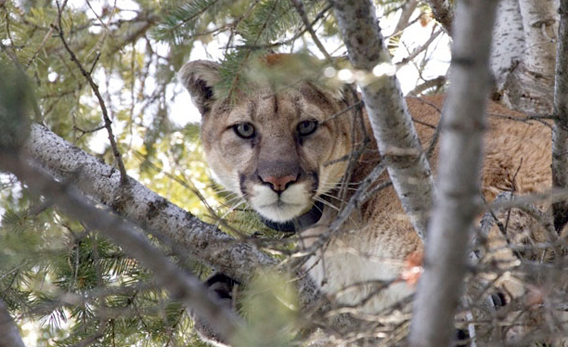

Mountain Lions on the decline in US: ‘We’re running against the clock,’ says big cat expert
By Morgan Erickson-Davis, Published in mongabay.com
An interview with cougar expert, Howard Quigley
It’s the widest-ranging native land animal in the Americas, yet is declining throughout much of its range. Mongabay talks with big cat expert Dr. Howard Quigley about the status and research implications of the elusive, enigmatic, and unique cougar.
It is thought that the forebear of the cougar migrated from Asia into North America over the Bering land bridge approximately 8 million years ago, where it evolved into the different cat lineages present today. Cougars subsequently invaded South America three million years ago when the isthmus of Panama formed to connect the two continents. Genetic studies have shown that today’s North American populations are all very similar, suggesting a population bottleneck contemporaneous with the megafauna extinction of approximately 10,000 years ago during which large North American mammals such as Smilodon went extinct. Researchers believe that during this time cougars were largely or entirely extirpated from the whole of the continent, with today’s populations refounded by cougars from South American.
Although it can weigh up to 220 pounds, making it the second largest felid in the Americas (after the jaguar), the cougar is actually more related to smaller cat species such as ocelots and lynx than it is to lions and tigers. Originally, it was even grouped in the same genus as the domestic cat (Felis), but in 1993 was given its own genus, Puma, which it shares with its closest living relative, the jaguarundi.
Interestingly, even though they are in separate subfamilies, cougars and leopards are capable of hybridizing. In the 1890s and early 1900s, an animal park in Germany bred a female cougar with a male leopard while a Berlin zoo bred a male puma to a female leopard. The resulting “pumapards” had the long body of a cougar with the rosettes of a leopard on a tawny or grey coat. Most died while young, and those that did reach adulthood grew to be only half the size of their parents due to genetic dwarfism.
STORY: Millions of Wild Hybrid Coywolves Roam Eastern US
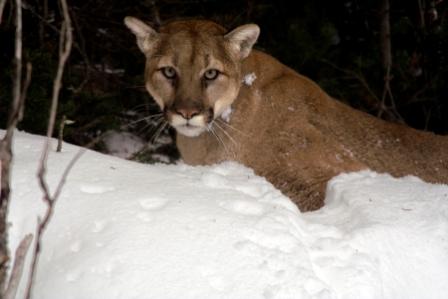  An adult cougar – photo by Larry Westbrook |
With habitat extending from the Yukon to the Andes, the cougar is the widest ranging land animal in the Americas due to their ability to live in virtually any environment. However, even with their vast range, there are estimated to be only 50,000 wild cougars in the world.
In South and Central America, laws enacted in 1996 outlawed the hunting of cougars in Argentina, Brazil, Bolivia, Chile, Colombia, Costa Rica, French Guiana, Guatemala, Honduras, Nicaragua, Panama, Paraguay, Suriname, Venezuela, and Uruguay. Cougars have no protection measures in place in Ecuador, El Salvador, and Guyana.
In North America, cougars became extirpated from most of the Eastern U.S. and Canada after European colonization. The only resident eastern population is the critically endangered Florida panther which occupies only five percent of its historic range and numbers just 50-100 individuals. Many states and provinces in the western portions of the U.S. and Canada have resident cougar populations, and all except California and the Yukon allow hunting. However, most have enacted certain protection measures. The lone exception is Texas, where hunting of the cats in largely unregulated. The state groups cougars with ticks and pigeons as “nuisance wildlife”, and allows anyone with a hunting or trapping permit to kill a cougar regardless of sex, size, or age.
Cougars are threatened by habitat loss and by direct persecution by humans. The latter is primarily caused by the perceived threat of cougars on livestock, although the risk of attacks on humans is sometimes used to justify the killing of a cougar near urban areas. In reality, cougars have a minuscule effect on livestock numbers. In Texas in 1990, for example, cougar kills amounted to 445 sheep (0.02 percent of a total of the state’s total of 2.0 million sheep and lambs) and 86 calves (0.0006 percent of the state’s total of 13.4 million cattle and calves).
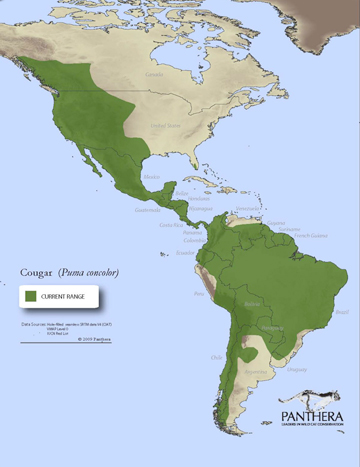  Cougar range map. Image courtesy of Panthera |
Attacks on people are incredibly rare, but are increasing due to expansion of human populations into cougar habitat. In the hundred years spanning 1890 to 1990, there were only 53 confirmed attacks by cougars on humans, resulting in ten deaths. From 1990 to 2004, the number of attacks had climbed to 88 with a total of 20 deaths. Even though the frequency of attacks on humans is relatively small, those which do happen are heavily covered by the media, effectively maligning cougars in the public eye and drawing attention away from the critical roles they play in many ecosystems.
However, the main reason behind cougar decline in the U.S. is habitat loss through degradation and fragmentation. Research shows that cougars need at least 850 square miles of uninterrupted habitat in order to persist with only a low risk of extinction. With urban areas becoming more numerous, many scientists are calling for the expansion of protected habitat corridors so that cougar populations could exist and move without needing to traverse through civilization.
One of the major players in cougar conservation is Panthera, an organization whose mission is to ensure the future of wild cats through scientific leadership and global conservation action. Panthera is the world’s largest dedicated funder of wild cat conservation, and in addition to cougars includes tigers, lions, cheetahs, leopards, snow leopards, and jaguars as its focal species. Panthera has sponsored many innovative conservation measures such as the Jaguar Corridor, a program that is working to connect jaguar habitats from the top of their range at the Mexican-American border all the way down to the end of their range in Northern Argentina, and the Snow Leopard Initiative which was launched in Beijing in 2008.
Panthera is currently conducting two projects which focus on cougar conservation: the California Cougar Project and the Teton Cougar Project. The Teton Cougar Project, a joint Panthera-Craighead Beringia South initiative in its ninth year, is working to gather data about the cougar population of Jackson Hole, Wyoming, and the southern Greater Yellowstone Ecosystem with the aim of increasing knowledge of cougar population dynamics and interactions with competing carnivores and humans.
  Cougar. Photo by Travis Bartnick |
The California Cougar Project aims to reverse the trend of habitat fragmentation and increase habitat resiliency by evaluating the existence and potential of corridors to link cougar populations within the state’s 99 million acres of optimal cougar habitat. The project also includes an outreach component to communicate the benefits of cougar conservation while educating communities about how to successfully live with the big cats.
Both Teton and California Cougar Projects are led by cougar expert and the Executive Director of Panthera’s Jaguar Program, Dr. Howard Quigley. Dr. Quigley conducted field studies of giant pandas in China, Siberian tigers in the Russian Far East, cougars in central Idaho, and jaguars in the Brazilian Pantanal, before joining Panthera in 2009. He is a member of the IUCN Cat Specialist Group and is called on for his expert advice on many issues including jaguar recovery in the U.S., cougar-human interactions, and jaguar-rancher conflicts in Latin America. Dr. Quigley has also written more than thirty scientific publications and popular articles.
In January of 2011, Dr. Quigley discussed the state of cougar conservation in the U.S. with mongabay.com.
—————————————
Cougar’s Travels Take a Bad Turn
When a mountain lion being tracked by scientists happens upon a family’s sheep pen, the outcome leaves no one happy.
By Mike Anton
First published: Los Angeles Times, September 25, 2010
Don Dyer, 48, repairs a fence at the family spread in the Japatul Valley east of San Diego. He has lived in the valley most of his life but had never seen a cougar in the wild. For eight weeks, M56 moved relentlessly, guided by a primordial compass. He covered more than 100 miles and climbed from sea level to a mile high. He traversed saw-toothed mountains, navigated busy highways and furtively skirted suburban neighborhoods.
The 20-month-old mountain lion, wearing a tracking collar affixed by UC Davis researchers, left his mother in the foothills of Orange County in early March and struck out on his own. He traveled south through Camp Pendleton, then turned east toward the high country of eastern San Diego County, which opens on the horizon like a centerfold in a coffee table book.
M56 stunned scientists by becoming the first cougar in a decade of study to cross Interstate 15 — most likely via an underpass where signs point to housing developments that have pushed deep into Southern California’s mountain lion habitat. Weeks later, M56 emerged from chaparral-choked wilderness and ducked under Interstate 8 about 45 miles east of San Diego.
Like any juvenile cougar, M56 was searching for food, potential mates and territory unclaimed by another male. Above all, he avoided people. He was learning to survive.
The night of April 24, he moved through a wooded area and stopped a few miles from the Mexican border, just north of Campo. After two months of moving south and east, M56 turned and headed northwest back into the woods.
Maybe it was the light of ranchettes less than a half-mile away. A stray dog might have spooked him. Or maybe he had picked up the scent of another cougar and turned to avoid a fight.
One thing is clear: M56 was about to make his first — and last — mistake. The dogs shattered the silence a couple of hours before dawn. Don and Jaime Dyer awoke and thought the same thing: Coyotes must be trying to get at their sheep. The Japatul Valley in the mountains of San Diego County is one of countless places in Southern California that is neither rural nor urban. It is country where man and nature coexist uneasily.
Dyers have lived here for 55 years, ever since Don’s father traded five acres in El Cajon for 190 acres along a creek a few miles of rugged backcountry from Campo. Coyotes and stray domestic dogs can be a problem here. Sheep are docile animals and make easy prey if left unprotected at night. Dyer had built a sheep pen from chain-link fencing he scavenged from the Del Mar Fairgrounds. It was 24 feet square and 5 feet tall — secure enough to keep coyotes out.
His daughter, Addie, began raising cows and sheep to sell when she was 9. They’ve won plenty of awards at fairs. More important, the animals have earned Addie about $50,000 through the years, money the 19-year-old is using for college.
When her father reached the pen that morning, he was startled by the grisly scene. Five of Addie’s 10 sheep had been slaughtered; the partially eaten carcass of a sixth animal would be found later in the brush about 20 yards away. “I thought it was one of my dogs,” Jaime Dyer said. The family had recently adopted an Akita, a powerful 100-pound hunting dog that wasn’t accustomed to being around livestock.
Jaime went back to bed but couldn’t sleep. “The thought of the dog doing this made me sick to my stomach.”
The next night, the Dyers locked up their dogs and secured their four remaining sheep in the pen. About 1 a.m., they were jolted awake again, this time by their stampeding cattle. Don Dyer grabbed a .22-caliber rifle. Outside, he found his cows in a circle, facing outward and shielding their calves in the middle. They looked like a wagon train under attack.
Whatever had frightened them was gone. In the pen, Dyer found a lamb and its mother dead. This wasn’t the work of a dog. “I’m about to be out of sheep,” he thought. “And my calves will be next.”
He stood in the dark holding his slender gun and wondered where the killer had gone. He realized how exposed he was and felt foolish. “I grabbed the wrong gun,” he thought.
Two days before the attacks at the Dyer farm, Winston Vickers was at a county park near Campo speaking at an annual gathering of long-distance hikers about to tackle the Pacific Crest Trail, which stretches from Mexico to Canada through California, Oregon and Washington.
Vickers’ topic was his expertise: mountain lion behavior. He didn’t know it but M56, one of his subjects, was passing in the forest nearby.
“Like any young dispersing animal, he was searching for territory he could call his own and moving through landscapes he was totally unfamiliar with,” said Vickers, a veterinarian and a researcher on the UC Davis Wildlife Health Center’s lion tracking project. “What we’re looking at is: What decisions do they make time after time?”
The study began in 2001 to assess the impact of lions on endangered Peninsular bighorn sheep in the desert mountains of Riverside, San Diego and Imperial counties. Over the years, the study’s scope has expanded, and the movements of collared cougars have shed light on health and disease issues, genetic patterns and the behavior of cats in the so-called wildland-urban interface.
One statistic stands out: Of 53 mountain lions that have been trapped, tranquilized and collared, 19 have been killed by vehicles or shot, far more than have died from natural causes.
“The closer lions are to people, the more likely they’re going to die,” Vickers said. “Any interaction with humans, broadly speaking, will likely end up badly for the lion.”
Mountain lions are fast and powerful; they can leap 18 feet into a tree and take down a bull elk six times their weight. They’re also solitary and elusive. Attacks on humans are extremely rare, despite the fact that more than half the state is considered cougar territory.
“Lions are among us constantly, and for the most part they stay out of trouble,” said Marc Kenyon, who oversees mountain lion studies for the state Department of Fish and Game. “When people report to us they’ve seen a mountain lion and ask what they should do, I tell them they should consider themselves extremely lucky because seeing one is very rare.”
Mountain lion attacks on pets and livestock are more common, although the extent is difficult to determine.
One measure is the number of lions legally killed under depredation permits issued by state wildlife managers. In the year ending Sept. 30, 2009, 103 lions were killed by permit. Relocation is considered too risky.
Mountain lions have been killed for preying on livestock in California since the Spanish friars brought cattle to the missions. In 1907, the state Legislature approved a bounty for cougars.
Jay Bruce, a tracker and guide at Yosemite National Park, was the state’s first official lion hunter. Starting pay was $100 a month and $20 for each animal killed. Bruce killed 668 lions over 31 years. Newspaper accounts and a 1933 documentary turned him into a folk hero.
“If I had a million dollars, I would still hunt lions,” he told a reporter. “The long chase over the snow, racing after the dogs through underbrush, swimming rivers, jumping chasms, alone in the wilderness — that’s life.”
The state abolished the bounty in 1963, and in 1990 voters approved Proposition 117, which outlawed sport hunting of mountain lions and designated them a “specially protected species.”
But they’re far from endangered. It’s estimated there are about 5,000 mountain lions in California, double the population in the 1970s.
Yet given that an adult cougar’s territory can range more than 100 miles, the continued fragmentation of their habitat concerns researchers, who say it’s inevitable that human conflicts with mountain lions will increase.
Particularly with young male lions such as M56.
“He was like a youngster who leaves home and is trying to make a living,” said Linda Sweanor, a wildlife scientist who has studied mountain lion behavior in the West for 25 years. “They’re still learning the ropes. Sometimes they take risks that an adult cougar would not.”
Don Dyer’s students raise sheep, pigs and chickens from conception to slaughter. They grow hay and learn to handle a rope. In a machine shop next to the rodeo grounds in Lakeside, they learn welding, plumbing and electricity.
“Anything you need to keep a farm running,” Dyer said. “Finals is always barbecued chicken.”
Dyer teaches agriculture as his late father did. But in a sense he’s teaching history. El Capitan High School may be home of the Vaqueros, but this former ranching community, a good drive from Dyer’s home, is now a far-flung suburb of San Diego. Only a handful of his 440 students will pursue agricultural careers.
“Most of the kids are three or four generations removed from farming. They’ve been raised to know animals from Disney — they’re all cute little calves and kitties,” Dyer said. “My job is to teach them how agriculture really works.”
Among the realities is that farm animals are production units, and natural predators are a cost of doing business.
Dyer, 48, has lived most of his life in the Japatul Valley. He had never seen a cougar in the wild. Although he knows that the entire region, rich with deer, is prime lion habitat, they had never posed a problem.
“Fate brought him to us,” he said.
Vickers, the UC Davis researcher, didn’t know of M56’s travels until the animal’s collar was returned to him. He says it was opportunity, not predetermination, that led M56 to Dyer’s sheep. He faults the Dyers for not enclosing the pen with a secured top, even if the family had never had a problem with cougars before.
“It’s surprising and sad that they’ve been out there that long and didn’t know what the threat was,” Vickers said.
But Dyer says a mountain lion attack could just as well have happened during the day, when his sheep and cattle are scattered and grazing. He believes M56 was an outlier: the rare lion bold or hungry enough to risk going after livestock.
“You can’t build a pen with a roof on it over 200 acres,” he said. “Guys who run herds of sheep, they employ sheepherders who watch over them all the time. I’m not a sheepherder. I’m a schoolteacher.”
Later, he would teach his students how the law works in such cases. He contacted federal agriculture officials. A depredation permit was secured from state Fish and Game officials. A federal trapper drove out to the Dyer place and baited a trap.
The next morning, M56 was in the cage. He was graceful and muscular with a flowing, regal tail and piercing yellow-green eyes. Jaime Dyer was surprised by how calm he was.
The trapper returned with a gun. Jaime left him to do his job.
“I did not care to watch,” she said later. “Was I happy he was dead? No. Why would I be happy he was dead? He was a beautiful animal.”
mike.anton@latimes.com
Copyright © 2010, Los Angeles Times
Updated 10 October 2021



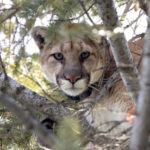
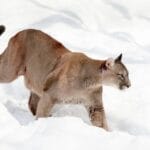








Give me a break! This guy is protecting his income and little else with this BS! We gave lions protection here in California with no sunset clause and their numbers exploded, effectively wiping out the big herds of deer, goats and sheep. Now lions are killing livestock, horses and people. The lesson exhibited in the movie The Lion King is lost on ignorant tree-huggers who fail to recognize the need for BALANCE in any ecosystem. Man rushes in with POLITICS and throws the entire ecosystem into a tailspin. When will the environmentalists listen to hunters and appreciate the need to manage the entire ecosystem…not regulate a single species? Same goes for wolves, sealions and many other predators with exploding populations due to special protection from POLITICALLY MOTIVATED ORGANIZATIONS SEEKING GRANTS! While researching the FACTS about lions, look at the change in their behavior over the past twenty years that they’ve enjoyed exclusive protection. Here in California there were only 3 lion attacks on humans from 1890-1985. Since 1986 there have been 12 confirmed lions attacks and some estimate that represents half the actual number because a lot of people here go missing while hiking, biking and camping in lion habitats. Moreover, on a nationwide review we find that between 1890-1990 there were only 53 confirmed lion attacks on humans. Between 1991 and 2004 there were 88 confirmed attacks.
Given that the average lion in the wild lives 12 years, this means that virtually all of the lions alive today have enjoyed protection and thus, have LOST their fear of humans. Add to this FACT that the a femail will produce 6-30 lion cubs over her lifetime and you can see how the population can explode. Nobody can say for certain just how many there are. The CA DFG estimated we had 2400 lions here in 1972 and 6000 lions by 1989. Then they enacted the total protection of lions. What do you suppose that number is now? Working against the clock? The author of this POS fiction is slanting the FACTS to ensure his income and mislead people into believing things not in evidence. You go do some REAL RESEARCH and you’ll soon learn the REAL FACTS are in direct opposition to this guy’s BS. The new age of lions do not fear you and in the face of diminishing food sources, may view you as easy prey. But hey, don’t listen to me…plug in your ipod and go for a jog in the wilderness.
Herds of wild deer were most definitely reduced not so much by the mountain lion, but for the same reason the lion’s numbers are decreasing: habitat encroachment by humans and their associated development. Mountain lions attacks on livestock are not statistically significant considering the small population of the former, as well as the need for ranchers to undertake their own predator control which would reduce most incursions through physical presence with ones herds.
The lion attacks cited again have more to do with humans encroaching on the habitat of the lion and not taking the proper precautions. Contrary to your assertions, I have had three encounters up close with lions showed the lion’s fear was quite real, and ran away when I challenged it. You are correct that lions in stressed interface with humans always are shot by Fish and Game and fast.
There is a place for humans and mountain lions to coexist in the environment, but the former must understand the latter to allow them to roam free in National Forests and protected areas, being careful to allow them proper room to roam under freeways and around housing developments, with access to streams so they can survive. When we build communities without respect for the wild animals, we suffer a small consequence, but they usually pay with their lives.
Larger Game
A female puma, out one dusk in search of larger game,
Froze in her tracks to hear one coming, singing out its name
[Crouch] “Cougar, cougar, toothsome tougar, felid, fauna fo-o-o-o-
Fum-fougar, hubba-hougar, o-sum cougar—ohh . . . hel-lo-o-o!”
He purred to glimpse her wildly tawny hide. She, for her part,
Assumed an air of coyfulness, as wildly beat her heart.
“I couldn’t help but hear,” she purred, “that most infectious song
You sang—so well. I would have loved, if known, to sing along.”
He swelled with cougar pride. “It’s called ‘The Name Game.’” “You don’t say!”
She cooed, and added, having her own game in mind to play,
“I hold the record for most animal names worldwide.
Some forty just in English,” she stressed with no little pride.
Ah, yes, he thought, she’s trying to impress me; that’s her game.
He knew it well, and he was not averse to play the same.
“My fearsome name does not roll off some tongue but it’s unfurled
I’m largest of the small cats [swells] fourth largest in the world.”
“Fourth. In all three Americas, I’m second largest cat,
Next to the jaguar, nothing, if you’re hidden, to sneeze at.
As such, I’m more related to the lynx and ocelot
Than lions, tigers, whom one doesn’t run across a lot
Here in Belize. At one time I was lumped in the same genus
(Felis) hmmph! as the domestic cat, How you demean us
Pumas—so they gave us our own, Puma, which I’m (taller)
Big enough to share with jaguarundi, so-o-o much smaller.”
“No namedropper, I’ll just say I’m cousin to the cheetah,
Fastest runner on the earth—and has to be to eat a
Meal upon the run. And, cougar close kin, I’m no slouch,
With longest back legs of all cats, in leaping from a crouch,
Some eighteen feet straight up, some forty feet ahead of me;
And climb? A near-plumb mountainside as easy as a tree.
Should one a distance off, yet wary, think that I can’t sprint,
I write its name in earth fast in Oh!-bit-you-wary print.”
“Well, it’s in print I’m, puma, most adaptable of cats,
And found in many climates and as many habitats,
From boreal to tropical, from desert to rainforest;
Steamy, boggy lowland, woodland, up to mountains hoarest;
Northern Yukon to the southern Andes, freeze to freeze;
In parallels of latitude, 110 degrees.
And every climate in between that you might care to name,
Wherein a hungry-for-love puma might find larger game.”
“I’m so love hungry I just can’t sit still; crepuscular,
I’m out each dawn and dusk in hopes my cougar-muscular,
Hence, powerful forequarters, neck, and, jaw shall serve to grasp
Such loving prey as I pray falls prey to my loving clasp.”
“A stalk-and-ambush predator, I’d never think to roar,
Like big cats, foolishly, and scare off whom I so pray for.
I wisely choose to purr, and when I have my prayed-for dream,
I chirp and whistle, hiss and growl, loose puma mating scream.”
“A lover of the wilderness, and solitary, shy,
I’m rarely seen, yet you bring out the beast in me, love’s cry.
The muzzle round my mouth’s pure white. Who hasn’t total blindness,
Sees I’ve drunk, and often, of the milk of puma kindness.”
“My eye shine’s a bright pale yellow, so I see clearly see
That we love hunters, getting ours, beget this irony:
Pre-daters of our litters, our pertetual survive-stock,
We are hunted, endlessly—as predators of livestock.
As the world record holder, oh! how I must strive
Both day and night to keep my many puma names alive,
Like catamount, and panther, mountain lion—wait, there’s more
Yet—mountain screamer, painter, even Puma concolor.”
“Well now, it’s funny you should pull those names out of your hat,
Since they’re the very ones I hear Man lay on this cou-cat.
And now that I think on it (I had one thing on my mind
When, seeking larger game, we met, and played the game in kind)
Those puma bragging rights you proudly claimed, I clearly see,
In prideful cougar hindsight, all apply as well to me.”
“Oh, that is just too weird. I swear, as God is judging me,
I had, just as you spoke, its mirror cat’s-eyepiphany:
That Man as often calls me cougar as he allocates
To me each one of your vainglorifying cougar traits.
O Cougar! don’t you see all that is in our synoname
Of Puma/Cougar, Cougar/Puma? We’re one and the same!
Man put that line [/] between us hoping to divide and conquer.
Concolors, we two see eye-to-eye, divine, and concur.”
“That, divinest Puma, we’re a couple must be true;
We look just like each other, as all couples come to do:
We’re rangy, swaybacked, ears erect, and both a tad small-headish,
Which swells nicely being tawny, silver-gray, or reddish.
We both look like we’re attacking Man—and who can blame us?—
When he lumps us in with housecats, simply to defame us,
Hunting us like dogs—we who’ve retractable, big claws
That do such credit to our large-sighs hold-you-tightly paws.”
“(Sigh) when I’m in that love embrace, it makes my head swim so,
The rest of me thinks taking that plunge quite the way to go.”
“Love, so does mine . . . ” [all names fly in the larger game of clinging,
Coupled with the coupling sound of fawning felids singing]:
“Couple, couple, toothsome touple, felid, fauna, fo-o-o-o-
Fum-fouple, hubba-houple, o-sum couple—ohhh . . . hel-lo-o-o!”
I doubt your premise. I think it more likely that mountain lions nationwide are at an 80 year high. Nationwide conservation measures and large numbers of deer have provided ample food in many areas. Lions are showing up in Chicago and Connecticut and downtown Capitola, near where I live. They are amazingly efficient killers, elusive and beautiful. There have been more attacks on livestock and humans. My dog was killed by a mountain lion this year and I was lucky to recover the body. There is plenty of habitat in this area. We felt the event was understandable and did not seek to eliminate the lion. I expect to see increasing attacks on animals and humans in the future unless the population wanes as populations do in natural cycles. We have speculated that the condor, whose range is expanding, may be benefitting from an increase in lion activity.
Pingback: No Imitation « T's FotoBlog
Pingback: Mountain Lions Manage Ecosystems: Not Sport Hunters | WilderUtopia.com
Pingback: Habitat Conservation, Not Hunting, Saves Grizzly Bears | WilderUtopia.com
Pingback: Millions of Wild Hybrid Coywolves Roam Eastern US